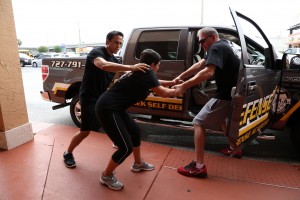June 2015 Self-Defense Professional
By Glenn Stevens:
Human predators, just like animals in the wild, often select their victims based on signals given off by their potential prey.
You are constantly communicating to the world through your actions and mannerisms. You are giving away little clues all the time. It is like any foreign language that can be learnt and interpreted. Some people become fluent at reading it; others have no idea. Muggers and criminals are very good at reading body language as it’s how they choose their victims and their “jobs” depend on it.
There was a study done by researchers Betty Grayson and Morris Stein (http://www.scribd.com/doc/35330362/Attracting-Assault-Victims-Nonverbal-Cues-Grayson-Stein) where they videoed pedestrians who were unaware that they were being filmed, walking down a busy New York City sidewalk. They then showed the tapes to 53 criminals who had all had been convicted of assaultive crimes ranging from murder to simple assault on a victim.
They were asked to talk about the videotaped persons in terms of being targets for assault. Within a few seconds, the convicts identified which pedestrians they would have been most likely to target. There was a clear consensus among the criminals about whom they would have picked as victims. Surprisingly, their choices were not based on gender, race, or age. Some small, petite ladies were not chosen as victims while some big burly men were. Why is that?

The researchers realized potential victims may be signaling their vulnerability to would-be assailants through gestures and body language and that the criminals were assessing the ease with which they could overpower the targets. This was based on several nonverbal signals—posture, body language, pace of walking, length of stride, and awareness of environment. These were personal attributes that increased a person’s likelihood of being criminally victimized.
Potential victims had movements that were perceived to be less fluid and more sporadic. Their walk lacked organized movement and flowing motion.
It may have been subtle but they were seen as being less coordinated than the non-victims. These people were viewed as less self-confident, maybe less athletic and fit, and so were much more likely to be exploited, whereas individuals who were not seen as potential victims had body movements that appeared to flow from the center of their bodies with their body parts appearing more interconnected.
Just like predators in the wild, criminals often attack the slowest of the herd. People who drag their feet, shuffle along, or exhibit other unusual gaits are targeted more often than people who walk fast and fluidly. The criminals were experts at spotting signs of vulnerability.
So how can you travel in everyday life looking less like a victim?
• You can be alert and pay attention to what is going on around you. Remember to scan your surroundings and take it in.
• Try walking tall with your head up and a confident stride without appearing arrogant.
• Know where you are going to and how to get there.
• Avoid excessive eye contact with strangers.
• Keep a comfortable distance between yourself and strangers.
• Be aware of exits and escape routes.
• TRUST YOUR INTUITION: if it feels wrong, it is wrong.
To Learn More About Becoming a Certified COBRA Instructor Visit: www.SelfDefenseCertified.com

